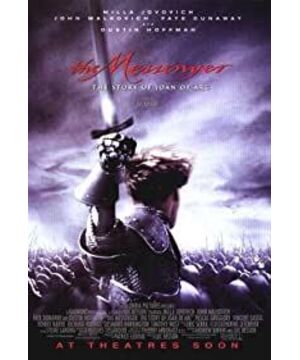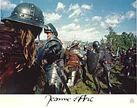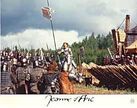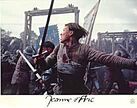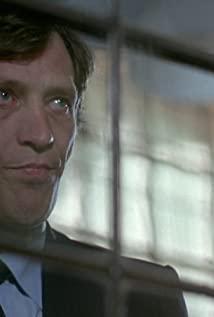Her parents owned about 50 acres of land and ran a farm, while her father also served as a less important official in the village, collecting taxes and leading the care of the village. The village is one of a small isolated area in northeastern France that remains loyal to the French crown, surrounded by Burgundian territory. During Joan of Arc's childhood, the village suffered several attacks, one of which even set the village on fire.
At that time a large area of Normandy in France was occupied by British troops, and these areas are likely to be permanently made British territory under the name of "Second Kingdom". The king of France at the time was Charles VI, who went mad in 1412, rendering him completely unable to handle political affairs. Two of the king's relatives, John the Fearless, Duke of Burgundy, and Louis, Duke of Orleans, often quarreled over the power of the regency and the custody of members of the royal family. When Queen Isabella's extramarital affair was rumored, the struggle between the two factions rose sharply, and each began to kidnap members of the royal family. The struggle reached its climax in 1407, when the fearless John planned to assassinate the Duke of Louis. The supporters of the two men were known as Burgundians (John) and Armagnacs (Louis).
King Henry V of England took advantage of this political chaos to invade France, winning a dramatic victory at the Battle of Agincourt in 1415, and then taking towns in northern France. The future King of France, Charles VII, assumed the title of Crown Prince at the age of 15 after all four of his older brothers died. His first major act was to conclude a peace agreement with John the Fearless in 1419, but this negotiation turned into a catastrophe. Charles promised to protect John's safety in advance, but during the negotiation John was killed by Armani. Yakpie was assassinated. The successor to the Duke of Burgundy was Philip III, so he changed his alliance with England, and large swathes of French territory were occupied by England and the Burgundians.
In 1420, Queen Isabella signed the Treaty of Troyes, which stipulated that "Henry V of England and his heirs shall succeed to the French crown, but Henry VI shall be with Princess Catherine, daughter of Charles VI. Married, and after the death of Charles VI, the throne will be succeeded by their children, and the two countries will be united." The treaty also raised concerns that the crown prince was actually the illegitimate son of the queen and the Duke of Orleans, rather than the king's own, depriving the crown prince of Charles. Inheritance, which was strongly opposed by the French nobility. Henry VI of England was not officially crowned due to his young age, and nominally became the common king of England and France. All this provided favorable conditions for the opposition of Charles VII.
By 1429, almost the entire north of France, and part of the southwest, was under foreign control. England occupied Paris, while the Burgundians occupied Reims. The importance of Reims is that it has always been the traditional location for the coronation and consecration of French kings, especially when none of the members of the French royal family claiming the throne have been crowned. England then launched an offensive against Orleans, which was on the Loire and became the last of the strategic points that could prevent the British from advancing straight into the remaining French territory. The existence of the French nation faced an unprecedented crisis, and according to modern historians, "the fate of the whole kingdom is tied to Orleans". But at the time, not many were optimistic about Orleans' future.
Revelation and Mission
According to the Inquisition's reply, Joan of Arc met the angels St. Michael, St. Margaret, and St. Catherine in 1425, one day when she was sixteen, under the tree behind the village, and heard a "voice" , and get "God's revelation". She was asked to lead troops to retake France, which was then occupied by the English, and to lead the crown prince to Reims for the coronation ceremony. Joan of Arc complied with the "voice" and in May 1428 she asked her relative Durand La Suix to take her to nearby Vauquelle to visit the local garrison commander Beautracott and explain her purpose, hoping to take her to the The seat of the Crown Prince - Chinon. But Botrycott just laughed at her and let her go.
Joan of Arc came again in January of the second year, accompanied by two soldiers who supported her. With their support, she received a second interview. During the conversation, she gave some magical war forecasts. It was predicted that the French army near Orleans would be defeated (the Battle of Herring). After news from the front confirmed Joan of Arc's prophecy, Beautracott finally agreed to escort her to Chinon. After hearing the news, Charles VII received Joan of Arc. In the reception palace, Joan of Arc did not salute with the person wearing the prince's costume, but found Charles VII, who was among the cronies, and told the secret talk of Charles and his staff. However, due to the deletion of this information by the Inquisition, the authenticity of the content cannot be verified. After the meeting she made a great impression on Charlie, who went on to instruct Joan of Arc in Poitiers to conduct background checks and theological tests to confirm her morality. At this time, Charlie's mother-in-law Yolande raised funds to launch an expedition to rescue Orleans. Joan of Arc requested to be part of the expedition and was dressed as a knight. Since she had no funds of her own, her armor, horses, swords, flags and entourage were donated by others. For this reason, historians offer the following explanation for why Joan of Arc was appointed:
"Year after year of shameful defeats on the battlefield, the French government was demoralized and discredited in the leadership of the army and the people. When Charles When the Crown Prince agreed that Joan of Arc should lead his army and prepare for war, he must have tried almost every formal, rational strategic choice and failed. Only a regime that had reached the end of its life and was completely helpless, Only in despair will I believe in a rural illiterate girl who claims to be instructed by God to command the army of the country."
In April 1429, Joan of Arc set out from Orleans to fight against the English army. Joan of Arc's army arrived on the battlefield on April 29, 1429, but the French commander at the time, the Duke of Dinois and other generals, drew up their own battle plan and fought without telling Joan of Arc. Joan of Arc was furious when she noticed this, ignoring the judgment of other experienced commanders planning to supply Orleans first, Joan of Arc advocated a direct attack on England, and she was involved in every skirmish, at the forefront of the battle, and with her With her obvious flag.
Joan of Arc despised the cautious strategy of the French generals, and on the battlefield she attacked the British fortresses with a frontal force. After capturing several forts, the British began to abandon other wooden defensive structures and concentrated their remaining forces to defend a stone fort that controlled the bridge outside the Union of Orleans, the Fort of Turrell. On May 7, the French began to attack Turrell, and Joan was carried off the front line by the soldiers after being shot in the shoulder by an arrow during the engagement, but she quickly pulled the arrow out and returned to the field, wounded, to lead The final offensive. But she still cried uneasy afterwards, which made people feel that she was still a girl, an ordinary farm girl, fighting for her mission! A girl for the nation!
A quick victory at Orleans led the French to plan further offensives. The British expected that the French's next target would be Paris or Normandy; the Duke of Dunois later confirmed that this was indeed the intended target, but Joan of Arc insisted that the attack should be on Reims. After a series of unexpected victories, Joan of Arc persuaded Charles to grant her and the Duke of Alençon full command of the army, and was granted permission to attack the bridge near the River Rolle as a prelude to the later attack on Reims. This was a rather bold proposition, since Reims was twice as far as Paris and had penetrated deep into enemy territory.
The French took Jarreaux on June 12, Meun-sur-Loire on June 15, and Beaugentis on June 17. The Duke of Alençon fully supported the decision made by Joan of Arc. . The other generals, including the Duke of Dinois, were also impressed by Joan's victory at Orleans and became loyal supporters of Joan of Arc. Joan of Arc also saved his life by warning Alençon to dodge the incoming artillery during the battle at Zara. During the same battle, she was also hit by a stone on her helmet while climbing a siege ladder, but she continued to fight. On June 18, the expected arrival of British reinforcements, commanded by the British commander John Fastov, the Battle of Party can be seen as a reversal of the Battle of Agincourt: the French vanguard at the British Longbow Before the formation of the soldiers was ready, they launched a surprise attack, annihilated or captured a large number of British troops in the next battle, and captured the British commander. Fastov, who escaped with a small group of soldiers, became a shameful defeat for the British. scapegoat. The French suffered only minimal casualties in the battle.
The French began their attack on Reims from Meun-sur-Royal on June 29 and neutralized Auxerre in negotiations with the Burgundian city of Auxerre on July 3, allowing the French to pass, The other towns passed by on the way also returned to the French side without resistance. And Troyes, who had signed the Treaty of Troyes before, surrendered without a drop of blood after the four-day siege. After the army arrived in Troyes, it was faced with the problem of insufficient food supply. Legend has it that Joan of Arc met a monk named "Brother Richard". Brother Richard had long preached in Troyes the warning that the end of the world was coming, The local farmers were switched to growing beans—a crop that ripened early, and the beans were just ripe when the army arrived, thus solving the food problem. This legend was cited by historian Lucy Smith, who asserted that Joan of Arc was actually playing a sanctified role rather than some actual ability.
Joan of Arc believed that there was no reason for people to kill, and she focused on her flag, not her sword. In recent interpretations of trial testimony, scholars have more often pointed out that the officers who followed her saw her as a resourceful tactician and successful strategist. "She continued to lead the army to a series of incredible victories that turned the tide of the war." The siege of England fell apart in July 1429, and the French army produced extraordinary victories under her leadership.
The city of Reims opened its gates on July 16, and on July 17, 1429, Charles VII became the official king of France with his coronation in the cathedral of Reims. At the time of the coronation, Charles VII's advisers had already begun to consider foreign policy, although Joan of Arc and Alençon strongly advocated an attack on Paris. Duke Philip of Burgundy then used the negotiation as a tactical means of delaying the army, secretly reinforcing the defense of Paris while negotiating. The French continued their advance towards Paris, securing the peaceful surrender of more towns along the way. The British army, led by the Duke of Bedford, met the French army on August 15, and the two sides were tied. The French then attacked Paris on September 8, and although Joan of Arc was wounded in the leg by a catapult during the battle, she continued to command the army until the end of the day's fighting. The next morning, she received an order from the royal family and ordered the French to retreat. Many historians attribute the retreat to a political blunder committed by the French minister, the Duke of La Tremoyer.
Joan of Arc became a famous French heroine at the age of 17, but was executed three years later at the age of 20. Captured by the Duchy of Burgundy in a skirmish at Compiègne in 1430, it was soon sold to England. The Ecclesiastical Court sentenced Joan to death for the crimes of "a heresy" and "witch". He was burned at the stake in Rouen on May 30, 1431. Joan of Arc was old when the English were completely expelled from France 20 years later Her mother persuaded Pope Callixter III to re-trial Joan of Arc's case, and finally vindicated her in 1456. Later, she was canonized by Pope Benedict XV on May 16, 1920.
Captured and tried Joan of
Arc Spent November and December without fighting at Loire-Charité, then went to Lagny-sur-Marne in March and to Compiègne on 13 May to fend off the British and Burgundians Offensive. Joan of Arc was taken prisoner in a skirmish on May 23, 1430. When she ordered the army to retreat back to Compiègne, she was at the rear of the army to make sure everyone was back in the city However, at this moment, the city of Compiègne was afraid that the British army would follow in and closed the city gates before all the troops had withdrawn. Joan of Arc and the remaining rear guard were captured by the Burgundians, and Joan of Arc was captured After being tied with ropes, they were taken to the tribe.
At that time, it was customary for a captive to be redeemed as long as the captive's family could pay a ransom, but this time the Burgundians did not want to do so. Many historians have accused Charles VII of No effort was made to rescue. She tried to escape several times, even jumping from a 70-foot tower on one occasion and fell into the soft mud of the dry moat without being seriously injured. After some negotiation, Duke Philip took the chaste Germany was handed over to England. Pierre Cochon, the scum of the Church of Beauvais in northern France, who played a key role in these negotiations and later trials, was England's faithful lackey and falcon, and felt it was his duty to ensure that Joan of Arc suffered punish.
The trial against Joan of Arc for heresy was purely political. The Duke of Bedford wrecked it all by declaring that the throne of the King of France should belong to his nephew, King Henry VI of England. The proceedings of the trial, which began in Rouen on January 9, 1431, were dominated by the British occupation government and were in many ways disorganized. Summarizing some of the main issues, the jurisdiction of Bishop Cochon, who is a judge, is only a legal assumption, and he was given the position because of his pro-British stance. Joan of Arc was tied with her hands behind the rope (when Europeans tried criminals at that time, no matter the size of the crime, they had to have their hands tied behind their backs) and escorted to the court for trial.
The UK government subsidised the cost of the entire trial. The priestly notary, Nicolas Bailly, was also appointed only to collect testimony against Joan of Arc, but did not present any evidence to the contrary. Therefore, the record of the whole trial proves that Joan of Arc has excellent intelligence. The most famous question in the record is: "Do you feel that you have received the grace of God?" Joan of Arc replied: "If not, I hope God will give it to me; if I have, I hope God will still give it to me."
This The problem is a trap. The dogma of the church at the time was that no one could be sure that he himself received the grace of God, and if she answered in the affirmative, then she had proved herself a heretic. And if her answer is no, then she admits her guilt. It is impossible for Jeanne to not understand this. But she chose yes. The notary, Boisguillaume, later confirmed that after the court heard Joan's reply, "all those who questioned her were dumbfounded" and had to suspend the day's interrogation. This question became very well-known later, and has become the subject of many fields in modern times.
Several court officials later confirmed that a large portion of the transcripts had been falsified, and that many clerics, including the inquisitors, were forced to attend, and others even received death threats from the British. According to the rules of the trial, Joan of Arc should be imprisoned in a church prison guarded by nuns, but the British imprisoned Joan of Arc in a prison guarded by soldiers. Cochon also rejected Joan of Arc's request for the Pope to come forward, as this would apparently stop his trial. In the end, the court concluded Joan's 12 criminal charges, but these charges contradicted the records at the trial. Under all kinds of coercion, the illiterate Joan of Arc was unaware of the imminent death penalty. The judges forced her to sign a completely incomprehensible public renunciation, which amounted to a direct confession. (Joan of Arc was tied with her hands behind her back and couldn't sign, so she should have just pressed a fingerprint) But the court's official record was a different document. When Joan of Arc signed the renunciation letter, it also stated that she agreed to wear women's clothing, and Joan of Arc wore men's clothing since she left her hometown until she was captured and mistakenly signed the renunciation letter. The fact that women wore men's clothing in those days was a religious rebuke, and a British-led trial convicted Joan of Arc, citing biblical rules about dress. But that charge was overturned in the retrial because it ignored exceptions to biblical doctrine.
Doctrinally, a woman can disguise herself as necessary to cross enemy territory, allowing her to wear armor in battle, arguing that doing so would allow her to avoid sexual harassment while sleeping in the wild. The priest who testified at the retrial confirmed that she wore men's clothing in prison to avoid harassment and rape, and that wearing men's clothing to maintain chastity was also a valid reason: it slowed down the attacker. The investigation of Joan of Arc at Poitiers at the direction of Prince Charles also pointed out that she was wearing men's clothes because her assignment was a job done by men, and therefore it was more appropriate to wear men's clothes. She kept her hair short throughout her military career and later in captivity, and was defended by the theologian in the retrial as well as Judge Brehal.
As Francoise Meltzer put it: "Descriptions of Joan of Arc reveal gender prejudices and prejudices in every age of mankind, but they do not tell us what Joan of Arc looked like. To be read, a sign of gender: the cultural imagination of each generation of a character of bravery, combined with the ambiguity of gender roles, makes her rather difficult to portray by posterity.”
Martyrdom of the Holy Virgin
, 1431 In May, Joan of Arc was sentenced to be burned at the stake. From May 20th to May 30th, Joan of Arc would be tied to the prison cart every day, paraded through the streets, and suffered humiliation.
The execution took place in Rouen, France, on May 30, 1431, and witnesses described the execution. After parading through the streets, Joan of Arc was taken to the execution ground and bound at the stake. She held the cross in her hand and prayed constantly, and asked the priest next to her to let her hold a small cross. Finally the fire was lit, and after a few minutes, it was all over. The British pushed aside the charred charcoal to reveal the charred body to prove to the crowd that she was indeed dead, and then burned the body again to prevent her ashes from being collected. Joan of Arc was only twenty years old when she died.
The British threw the remaining ashes into the Seine. The executioner who set the fire later described him as "very afraid of going to hell for burning a heroine." A trial was re-run after the war. Calixter III authorized the retrial at the request of Joan of Arc's elderly mother, Isabella Duck, and Jean-Brehar, chief judge of the French Inquisition. The trial began with the retrial of the case by the priest Guillaume Bouille, and in 1452 an investigation under the leadership of Brehal was carried out, with a formal verdict in November 1455. Many clergymen from all over Europe participated in the trial, which was conducted according to standard court rules. A team of theologians also analyzed the testimony of 115 witnesses. Finally, Brehal came to a conclusion in June 1456, describing Joan of Arc as a saint who sacrificed for justice, and pointed out that Pierre Cochon, who led the trial at the time, wrongly convicted Joan of Arc for his own secular interests. The court officially declared Joan of Arc's innocence on July 7, 1456.
post-mortem impact
The Hundred Years' War continued for 22 years after Joan's death, and Charles VII managed to retain the legitimacy of the French king without being defeated by Henry VI, the claimed successor of England. Britain also lost its alliance with Burgundy, which France managed to draw closer to France in the Treaty of Arras in 1435, before Britain could reorganize the generals and longbowmen it lost in 1429. The Duke of Bedford, England's regent, died the same year, making Henry VI, at just 12, the youngest English king without a regent. The shift in Burgundy's position and the inept leadership of Henry VI were probably the main reasons for the end of the war. Kelly DeVries argues that Joan of Arc's use of artillery for offensive use and frontal attack tactics also influenced the French in subsequent wars.
Joan of Arc became a semi-legendary character for the next four hundred years. Records of her come mainly from chronicles, and five original manuscripts of the first British-led trial were found in old archives in the 19th century. Soon historians also found the full record of the retrial, including the testimony of 115 eyewitnesses, as well as a record of the first trial in Latin. Numerous letters from the time were also found, three of which were signed by Joan of Arc "Jehanne" with waving handwriting showing that she was still learning to write. These first-hand accounts are documents left over from two trials, making them a rather unusually rich source, as DeVries says: "No medieval figure, male or female, has been as extensively studied as Joan of Arc. "
Joan of Arc came from a humble little village and was just an illiterate 18-year-old rural girl, but in just a few years became a legend. Before Joan of Arc, both Britain and France used the millennium-old Salic succession to justify this war, which was originally just a conflict between kings over inheritance rights. Joan of Arc brought a different meaning to the war, as described by Jean de Metz: "Many of our (French) kings are of English blood; but are we going to be English?" and Stephen Richey said: " She turned an otherwise tedious inter-dynastic conflict, in which ordinary people suffered but was not interested, into a fiery crusade to defend one's homeland." Richey also described her influence on future generations:
"Five centuries after her death, everything has been remembered for her: (she was) a fanatical believer, a religious mystic, a naive and tragic pawn to be played with by those in power, and at the same time The founder and symbol of modern nationalism, the adored heroine and saint. Even in the face of the threat of torture and death at the stake, she persisted in the voice she heard from God. Whether that voice was real or not , her deeds will shock all who hear her story."
At the same time as her execution was being re-investigated after the war of 1452, the Church announced that Orleans had been approved as one of the places of pilgrimage for her glorious deeds in Orleans. One, and an amnesty was granted to local criminals. In 1456, more than twenty years after Joan's sacrifice, Pope Callixter III vindicated Joan of Arc. Joan of Arc was used as their symbol by the Catholic League against Protestants in the 16th century. Joan of Arc was blessed in 1909, thanks to the efforts of Félix Dupanloup, bishop of Orleans from 1849 to 1878. She was canonized as a "Virgin" by Pope Benedict XV on May 16, 1920, and her feast day was set on May 30. She became one of the most popular saints in the Roman Catholic Church.
Joan of Arc was not a feminist, she played the role of a special person according to religious tradition, representing the calling of God regardless of social class. She strictly forbade the French army to attract women into the camp, and on one occasion even beat the camp prostitutes with the back of a sword to drive them away.
However, many of the very important help in Joan's life came from women. Charles VII's mother-in-law, Aragorn, confirmed Joan's virginity in the initial investigation of Joan of Arc, and funded an expedition to rescue Orleans. After Joan of Arc was captured at Compiègne, Madame Jean, the aunt of the Count of Luxembourg, also improved Joan's life in prison and possibly delayed her handover to the British. Finally, Anne, the Duchess of Bedford, the Regent of England, confirmed that Joan of Arc was still a virgin before the trial. Therefore, the court could not accuse Joan of Arc of being a witch, and also provided evidence for Joan of Arc's innocence and sainthood. Joan of Arc became a brave and positive positive character in the eyes of women.
Joan of Arc has often been used as a political symbol in France since Napoleon, with liberals emphasizing that she was born into a humble and ordinary family, and early conservatives emphasizing her support for the king. Later conservatives emphasized her nationalism. In World War II, the Vichy government and the French resistance all used Joan of Arc as one of the symbols: the propaganda of the Vichy government emphasized her deeds against the British, showing the scene of the British warplanes bombing Rouen on the posters, and Complemented by the caption: "They always come back to show atrocities." The rebels underscore her confrontation with foreign occupation and her hometown of Lorraine being controlled by the Nazis.
Traditional Catholics, especially in France, also use Joan of Arc as one of their symbols. In 1988, the French cardinal Lefevre Masset, who opposed the Pope's reforms, was excommunicated, and his supporters put him and the St. Joan of Arc was excommunicated on a par. Three French navy warships are also named after Joan of Arc, and the active duty is a helicopter aircraft carrier. The recently controversial French party Front National has also called on Joan of Arc, featuring her portrait in publications, and using the burning tricolor as a symbol of martyrdom. But opponents of the party often ridicule the appropriation of Joan of Arc's image. The second Sunday of May every year is also designated as a national holiday in honor of Joan of Arc.
View more about The Messenger: The Story of Joan of Arc reviews


